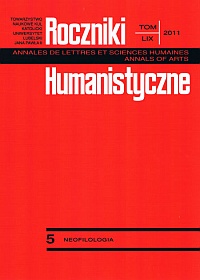Dative Causatives in Hungarian
Abstrakt
[Abstrakt tylko w j. polskim / Abstract only in Polish]
Struktury kauzatywne z celownikiem w języku węgierskim
W artykule przedstawione są argumenty za tym, że w języku węgierskim konstrukcje kauzatywne z celownikiem zachowują się w ten sam sposób, co konstrukcje kauzatywne z biernikiem, o ile obie te struktury wykazują cechy kontroli. Jednym z powodów uzasadniającym zaproponowaną analizę jest to, że jest ona w stanie wyjaśnić, dlaczego kauzatywy z celownikiem nie akceptują nieprzechodniego dopełnienia w formie zdania niefinitywnego; fakt, który pozostaje niewyjaśniony w ramach analizy odwołującej się do ECM/Kontroli celownika zaproponowanej przez Tóth (1999). Dobrze znane ograniczenie przechodniości derywowane jest przy użyciu wymogu dotyczącego tego, że cechy zgody z dopełnieniem czasownika kauzatywnego muszą zostać sprawdzone. Zaproponowana analiza jest również w stanie pomieścić wyrażenia emfatyczne i kwantyfikujące występujące w domenie C w zdaniu niefinitywnym; fakt, z którym nie mogą sobie poradzić ani analiza oparta o restrukturyzację (Guasti 1996, 1997), ani analiza oparta o związek zdań (Den Dikken 1999, (2004)). Cześć pierwsza wprowadza dane węgierskie i omawia wcześniejsze podejścia. Cześć druga pokazuje, że kauzatywy z celownikiem zachowują się pod względem składniowym tak jak kauzatywy z biernikiem, co zostało przyjęte jako dowód na to, że mają one identyczną strukturę. W części trzeciej omówione są niektóre zalety zaproponowanej analizy. Część czwarta zawiera podsumowanie artykułu.
Bibliografia
Ackerman, F. 1992. “On the domain of lexical rules: Hungarian causatives and wordhood”. Approaches to Hungarian 4:9-37.
Alsina, A. 1992. “On the argument structure of causatives”. Linguistic Inquiry 23:517-555.
Andrews, A. 1982. “The representation of case in Modern Icelandic”. Bresnan, J. (ed.) The Mental Representation of Grammatical Relations. Cambridge, Mass: MIT Press. 427-503.
Baker, M. 1988. Incorporation. A theory of grammatical function changing. Chicago: Chicago University Press.
Bartos, H. 1997. “On subjective and objective agreement in Hungarian”. Acta Linguistica 44:363-384.
Belletti, A. & L. Rizzi 1988. “Psych-verbs and theta theory” Natural Language and Linguistic Theory 6:291-352.
Benedicto, E. 1995. “Mn’e n’e čitaetsja: relativized modality, datives and reflexive suffixes”. UPenn Working Papers 2:1-17.
Burzio, L. 1986. Italian syntax. Dordrecht: Reidel.
Cardinaletti, A. 1995 (1997). “Subjects and clause structure” Haegeman, L. (ed.): The New
Comparative Syntax. London: Longman. 33-64.
Chomsky, N. 1981. Lectures on government and binding. Dordrecht: Foris.
Chomsky, N. 1995. The minimalist program. Cambridge, Mass: MIT Press.
Dalmi, G. 2000. “The structure of psych-impersonal predicates”. Proceedings of the Scandinavian Conference in Linguistics 18. University of Lund. 193-207.
Dalmi, G. 2005. The role of agreement in non-finite predication. Linguistik Aktuell 90. Amsterdam: John Benjamins.
Den Dikken, M. 2004. “Agreement and clause union”. É.Kiss, K. & H. v. Riemsdijk (eds): Verb Clusters. A study of Hungarian, German and Dutch. Linguistik Aktuell 69. Amsterdam: Benjamins. 445-499.
É. Kiss, K. & F. Kiefer 1994. The syntactic structure of Hungarian. Syntax and Semantics 27. New York: Academic Press. 1-84.
É. Kiss, K. 1998. “Multiple topic, one focus?” Acta Linguistica 45:3-30.
É. Kiss K. 2002. Hungarian syntax. Cambridge: Cambridge University Press.
Farkas, D. 1987. “DO pro in Hungarian”. Kenesei, I. (ed.): Approaches to Hungarian 2:191-213. Szeged: JATE.
Guasti, M-T. 1992. “Incorporation, excorporation and lexical properties of causative heads”. The Linguistic Review 8:202-232.
Guasti, M-T.1996. “Semantic restrictions in Romance causatives and the incorporation approach”. Linguistic Inquiry 27:294-313.
Guasti, M-T. 1997. “Romance causatives”. Haegeman, L. (ed.): The new comparative syntax. London: Longman 124-145.
Hetzron, R. 1975. “The presentative movement, or why the ideal order is VSOP”. Li, C.(ed.): Word order and word order change. Austin: University of Texas Press. 347-388.
Jaeggli, O. 1986. “Passive”. Linguistic Inquiry 177: 587-622.
Kenesei, I. 1994. “Subordinate clauses”. Kiefer, F.& K. É. Kiss (eds): The syntactic structure of Hungarian. Syntax and Semantics 27. New York. Academic Press. 275-354.
Komlósy, A. 1999. “A műveltetés”. [Causation]. Strukturális magyar nyelvtan 3. Morfológia. [The structure of Hungarian 3. Morphology.] Budapest: Akadémiai Kiadó. 215-291.
Koster, J. & R. May. 1982. “On the constituency of infinitives”. Language 58:116-143.
Larson, R. 1988. “The double object construction”. Linguistic Inquiry 19: 335-391.
Neidle, C. 1986. The role of case in Russian. Dordrecht: Kluwer.
Puskás, G. 1997. “Focus and the CP-domain”. Haegeman, L. (ed.): The new comparative syntax. London: Longman. 145-165.
Puskás, G. 2001. “On negative licensing contexts and the role of n-words”. Talk given at ICSH 5. Budapest.
Tompa, J. 1965. A mai magyar nyelv rendszere. [The system of present-day Hungarian language]. Budapest: Akadémiai Kiadó.
Sigurðsson, H.A. 2000. “To be an oblique subject”. Working Papers in Scandinavian Syntax 66:1-32.
Sigurðsson, H.A. 2004. “Agree and agreement: evidence from Germanic”. Abraham, W. (ed.): Focus on Germanic typology. Studia Typologica 6:59-99. Berlin: Akademieverlag.
Sigurðsson, H. A. 2006. “The case of PRO”. Ms.
Surányi, B. 2002. “Multiple operator movement in Hungarian”. Ph.D. dissertation. Utrectht.
Thráinsson, H. 1979. Complementation in Icelandic. New York. Garland Publishers.
Tóth, I. 1999. “The inflected infinitive in Hungarian”. Ph.D. dissertation. Tilburg.
Copyright (c) 2011 Roczniki Humanistyczne

Utwór dostępny jest na licencji Creative Commons Uznanie autorstwa – Użycie niekomercyjne – Bez utworów zależnych 4.0 Międzynarodowe.





